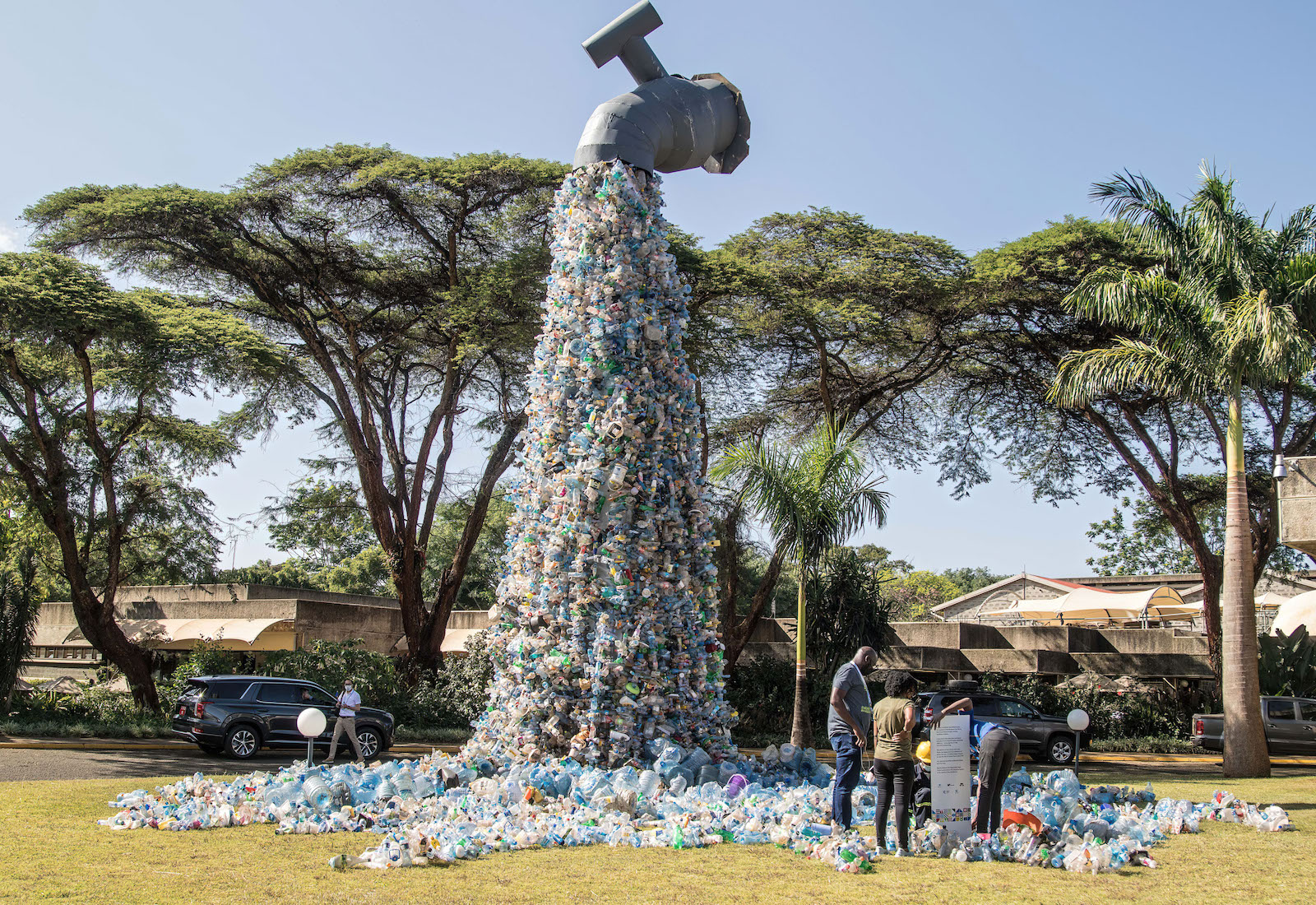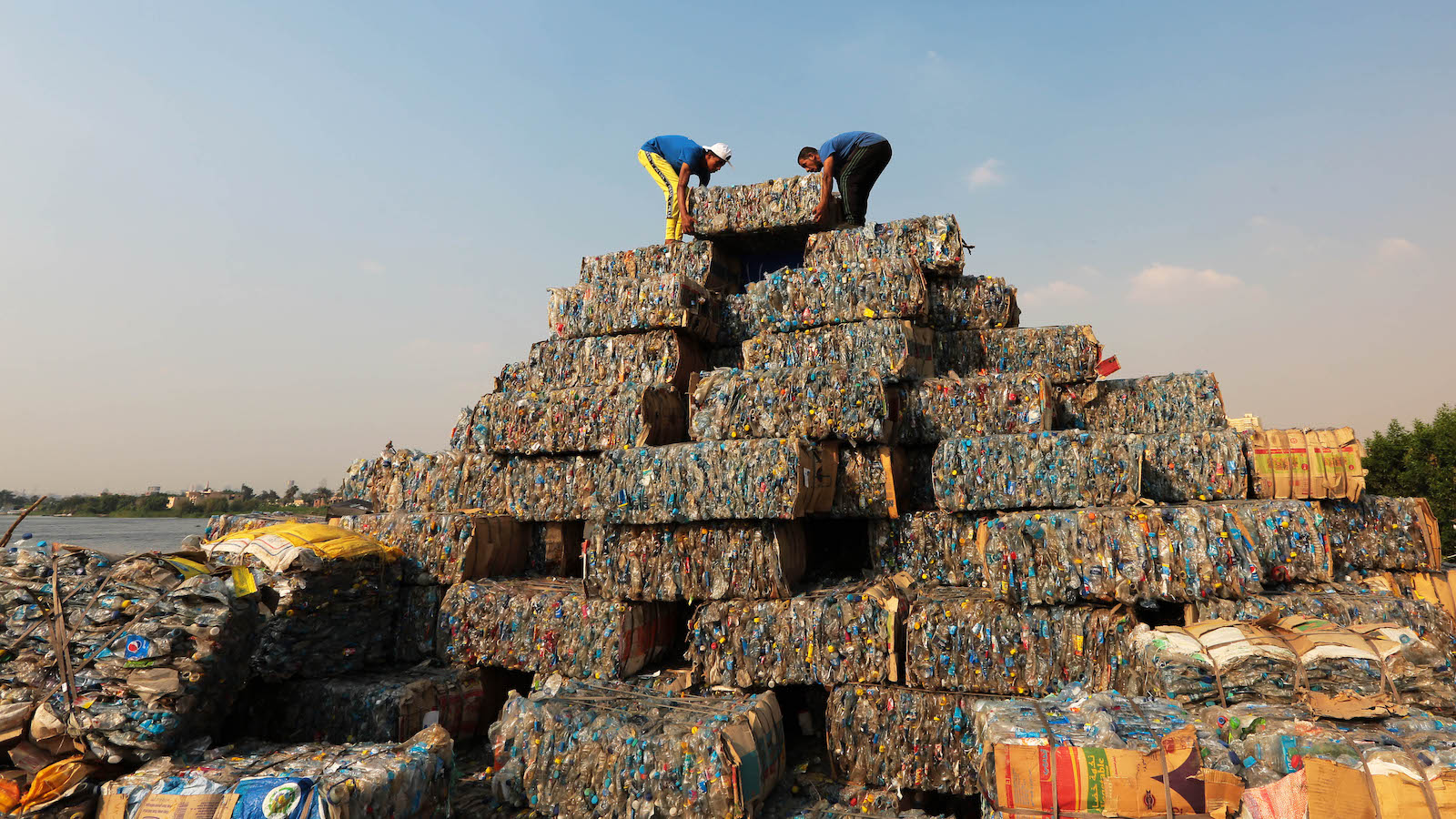In the middle of the Egyptian desert, just outside Cairo, a new sculpture has gained the singular distinction of being the world’s “largest plastic waste pyramid.”
Measuring nearly 33 feet high and weighing some 18 metric tons, the sculpture — made of plastic litter removed from the Nile — is truly gargantuan. The sculptors behind say it should serve as a stark message to leaders at COP27, the international climate conference that began in Sharm el-Sheikh last week, about the “incredible crisis” of plastic pollution.
“Our installation will really draw attention to the scale of the problem of plastic waste in our rivers and oceans,” Justin Moran, founder of Hidden Sea, a wine company that co-sponsored the art installation, told Packaging News. The brand, which targets “socially conscious consumers” is using the sculpture to launch an initiative called 100YR CLEANUP, which is supposed to raise enough money to continuously remove plastic from the environment for the next 100 years.
The plastic pyramid is eye-catching, but some environmental advocates say its focus on plastic cleanup is behind the times. They argue that what’s needed now is public pressure on policymakers and the petrochemical industry to stop making so much plastic in the first place.
“I’m not saying we shouldn’t do cleanup,” said Thalia Bofiliou, a senior investment analyst for the nonprofit financial think tank Planet Tracker, “but we shouldn’t do only that.” Plastic and packaging companies are planning to make more and more plastics, Bofiliou said, and unless they “take responsibility and reduce plastic production, then the issue is not going to be resolved.”
There are already 140 million metric tons of plastic in the planet’s oceans and rivers. By 2060, the Organization for Economic Cooperation and Development estimates that number will skyrocket to nearly half a billion metric tons, with annual plastic leakage to the natural world doubling to 44 million metric tons a year. Meanwhile, the 100YR CLEANUP is pledging to remove 1,500 water bottles’ worth of plastic from the environment for every $100 it raises.
The 100YR CLEANUP isn’t trying to clean up the planet on its own: Considering that the weight of a standard 600-milliliter water bottle is 0.93 ounces, the initiative would need to raise roughly $1.26 trillion to scoop up the world’s plastic pollution by 2060 — and then raise $113 billion each subsequent year to try to keep up with the still-accumulating piles of plastic bottles, bags, cutlery, and other trash.
But even similar removal efforts haven’t made a dent in existing plastic pollution to date. The Alliance to End Plastic Waste, an industry-founded nonprofit whose members include major polluters like Exxon Mobil, Shell, and the plastic-maker Braskem, only managed to collect about 4,000 metric tons of plastic trash over the first three years of its existence — just 0.04 percent of its own waste collection goal and about 0.006 percent of the plastic pollution that was generated during that time.

Instead of just calling for more cleanups, Bofiliou said advocates should spotlight companies that are responsible for plastic pollution and demand they be held accountable. Given the plastic waste pyramid’s proximity to COP27, the Coca-Cola Company could have been an easy target; the multinational beverage manufacturer is sponsoring the climate conference but has lobbied against legislation to address the plastics crisis. It was recently ranked the world’s biggest plastic polluter for the fourth year straight.
The pyramid is not the first piece of public art designed to call international attention to the plastic crisis. Another sculpture, featured over the summer as the United Nations discussed a global treaty on plastics, depicted plastic trash pouring out of a giant spout, urging policymakers to stem the metaphorical flow. Hidden Sea co-sponsored both the giant spout installation and the new plastic waste pyramid. Moran, Hidden Sea’s founder, told Grist “we need to turn the plastic tap off.”
A spokesperson for the pyramid’s other co-sponsor, Zero Co, a body care and cleaning product company that makes refillable packaging, told Grist the business also supports “the elimination of producing or using single-use plastics.” They said the business hasn’t focused on this messaging in pyramid press materials because it “didn’t want to delve too far away from the story and complicate messaging.”
Aarthi Ananthanarayanan, director of the nonprofit Ocean Conservancy’s climate and plastics initiative, defended plastic cleanups and the waste pyramid. Despite the enormity of the plastic pollution problem, she said cleaning up even a small amount of plastic trash can engage and benefit local communities. She stressed, however, the need to highlight plastics’ entire life cycle and cradle-to-grave impacts — including not only how they mar rivers and beaches but how their production contributes to climate change.
“What I wish they would have said is, ‘Plastics are fossil fuels — this is a pyramid of fossil fuel waste,’” Ananthanarayanan said. They didn’t, but if publicity around the waste sculpture helps draw that connection even a little bit she added, “I’ll take it.”



